Introduction to IoT
The Internet of Things (IoT) is an ecosystem of connected physical devices/objects that are accessible through the internet. This introduction to IoT includes insights into its components, the benefits of IoT, and high-level architecture. IoT is a system of interrelated devices, digital products, objects, people, or animals that are provided with unique identifiers (UIDs). This fundamental understanding of what is Internet of Things enables the transfer of data over a network without requiring any human interaction.
This blog aims to provide an introduction to IoT for beginners, shedding light on its market potential, high-level architecture, benefits of IoT and practical use cases to provide a real perspective on IoT.
It’s important to note that while IoT is significant in terms of everything, its technologies and standards are still evolving. The benefits of IoT are vast, and it’s expected to undergo more changes in the coming years. IoT’s reach is expansive, connecting 4 billion people on the planet through multiple devices and applications, making our lives easier and faster.
The new wave of connectivity extends beyond smartphones and laptops, thriving towards connected cars, smart homes, wearables, health care, smart cities, and many more. This comprehensive introduction to IoT helps these devices bridge the gap between the physical and digital worlds, enhancing the quality and productivity of industries, society, and life.
The Growth of IoT
Firstly, let’s discuss how IoT or Internet of Things has gained a lot of importance in the past few years globally. Let us also take a closer look into India specific statistics
- The global IoT market is expected to reach $1.1 trillion in 2023, according to a new study by International Data Corporation (IDC).
- Demand for IoT has gone up by more than 300% in the last few years.
- with more than 10 million jobs globally in the next five years.
- Over 60% of IoT-related jobs will be generated by startups, highlighting the agility and innovation
- There are tremendous opportunities for further growth with nearly 120 IoT firms in India, offering solutions in the IoT segment.
- In 2022, spending on digital transformation (DX) is projected to reach 1.6 trillion U.S. dollars. By 2026, global digital transformation spending is forecast to reach 3.4 trillion U.S. dollars.IoT plays an important role in this digital transformation.
In the similar lines, the number of devices are growing at a very fast pace. Every device we are using on a daily basis is getting connected to the internet. By 2030 about 29.42 Billion devices are expected to be in production. This presents a very important use case and potential opportunity for IoT.
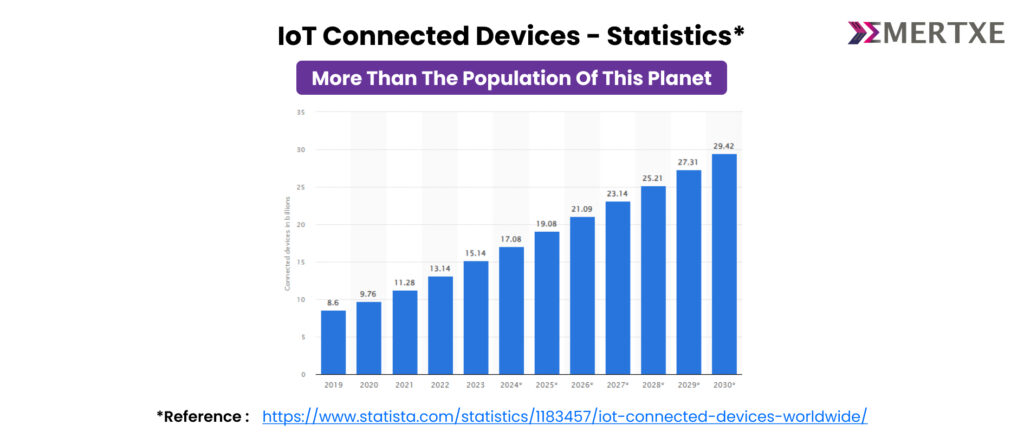
Components of IoT
Now that you have a brief idea about how IoT works at a high level, let us start building architectural understanding. Certainly, here is the diagram to give you a high level view
IoT architecture is a structure of numerous elements. In simple words, IoT architecture has five major components. Here is a description of the components of IoT.
1. IoT Device
IoT devices can be wireless sensors, software, actuators and computer devices. They are fixed to a specific object that runs through the internet. These devices enable the transfer of data among objects or people automatically without any interference of human resources.
For example Fitbit is an IoT device which communicates with an app via the internet and provides us with so many insights about our health.
2. IoT Gateway
IoT gateway is a device or a software program that serves as a connection point between cloud and multiple IoT devices. All the information moving to the cloud or vice versa has to pass through the IoT gateway.
IoT gateway provides extra security for the IoT network and the data that is being transported. An array of IoT devices connect with IoT gateway via low-range protocols (ex: Bluetooth Low Energy or BLE).
The gateway in turn uses web-scale standard protocols (ex: Message Queue Telemetry Transport or MQTT) to access the internet. Some of the commonly used protocol information is given below.
3. Network
Network is the bridging element that connects an array of IoT gateways to the Cloud platform by traditional TCP/IP network. It has been existing over years connected with a suite of protocols.
Now the same network has an indeed meaning of being “glue” that bridges everything (IoT device, IoT gateway, Cloud and application eventually).
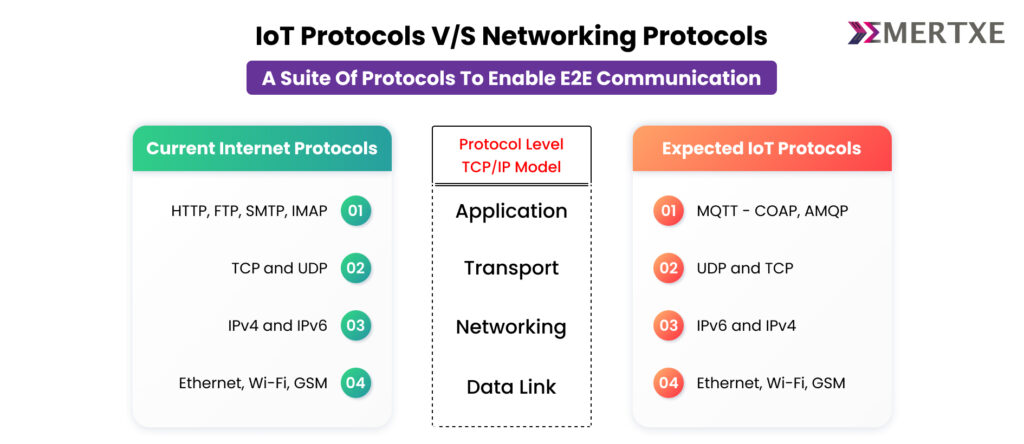
4. IoT Cloud
Cloud is a platform that takes a huge volume of data generated. They receive them through IoT gateways which in turn have tons of devices behind them. Since the amount of data handling is very significant it will have following characteristics.
- Web services – Ability to handle incoming client request and response
- Scalability – Ability to scale-up or scale-down depending on the data / network traffic
- Distributed – Inherently support distributed computing to handle resources
- Business Intelligence / Analytics – By analyzing big data and derive analysis
- Cost optimization – Provide facilities to customer to achieve results in optimized way
Today almost all the most important giants like Google, Amazon, Microsoft, IBM are offering their own IoT platforms. All of them provide key features mentioned above and much more.
5. Applications
The synthesized data for the end user to derive meaningful insights. The application typically provides an User Interface (UI) which the user can get the final insights (ex: Home devices status) or even trigger some action (ex: Switch ON / OFF).
Again this interface can be anything ranging from a mobile application, custom dashboards on panels or simply a web interface.
IoT Use Case 1: Smart Home
In today’s world everyone wants a comfortable lifestyle. IoT makes our lives simpler and more convenient. A smart home is everyone’s dream home. Wouldn’t you love it if you could switch on the air conditioner before reaching home or turn off the lights even after leaving home?
Everyone is so busy catching up with their work that they might miss out on a few things at home in a hurry. Here IoT helps us wonderfully in connecting us with the devices and notifying us about everything at home even when we are at work or anywhere else.
Not only that, IoT helps you to manage your home smarter. You can water your garden by sitting in the office with just one tap in your mobile application.
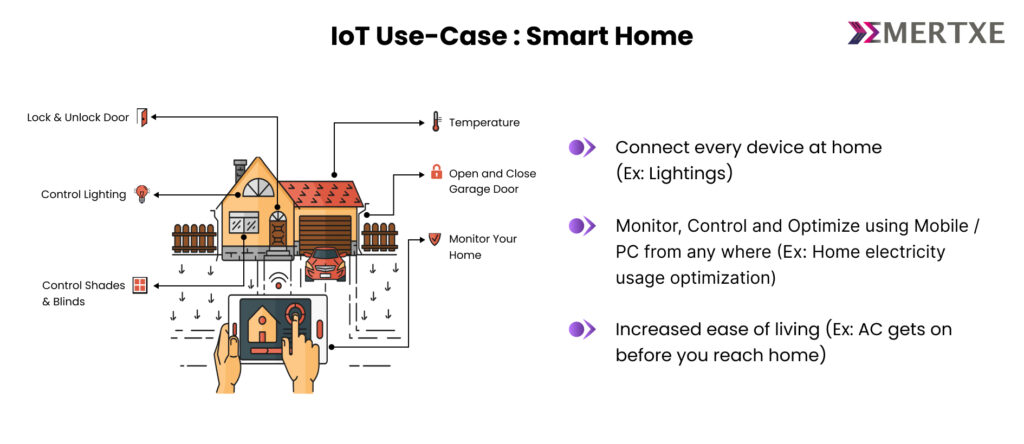
Let us talk about one such aspect, turning on and off lighting at home which is generally called smart lighting. Smart lighting generally uses mesh networking where each device i.e a smart bulb(that includes a WiFi connection to it) is wirelessly connected to its nearest neighbour.
This network is controlled by a hub that plugs into your router which enables the other networked devices such as a smartphone, tablet which eventually communicates with the bulbs.When we are away from home also we can control the lighting by turning on or off the lights with just one tap.
This data gets saved in the cloud from there we can access it on our smartphones. We can check from our smartphones, if any lights are on, if so we can turn it off from wherever we are. In the same way we can also turn on the lights for any particular area.
Smart lighting comes with additional features such as dimming the light or changing the color of the light based on our requirements. This helps us to optimize our usage of power and we can save a lot of electricity.
Many devices or sensors (1 – IoT device) connect to a main processor which is the gateway (2 – IoT gateway). The gateways perform many important functions such as device connectivity, security, protocol translation, data filtering, management and many more.
The network or router (3 – Network) connects the gateway to the cloud using various protocols. The data of the lighting in the house is saved in a cloud (4 – cloud). With the help of an application in a smartphone (5 – Application) one can see the data present on the cloud and keep a check on the home.
IoT Use Case 2: Smart Factory
A smart factory is highly digitized and provides connected functionality that relies on smart manufacturing. The concept of the smart factory is considered an important outcome of the fourth industrial revolution or known as Industry 4.0.
A smart factory works by employing technology such as Artificial Intelligence(AI), Internet of Things(IoT), Big Data, Robotics, Analytics, and many more. The characteristics that define a smart factory are visibility, connectivity and autonomy.
Factories have for long relied on automation but smart factories are taking this step much further and are able to conduct without any human intervention. Through the use of modern technologies smart factories can learn and adapt to them much faster.
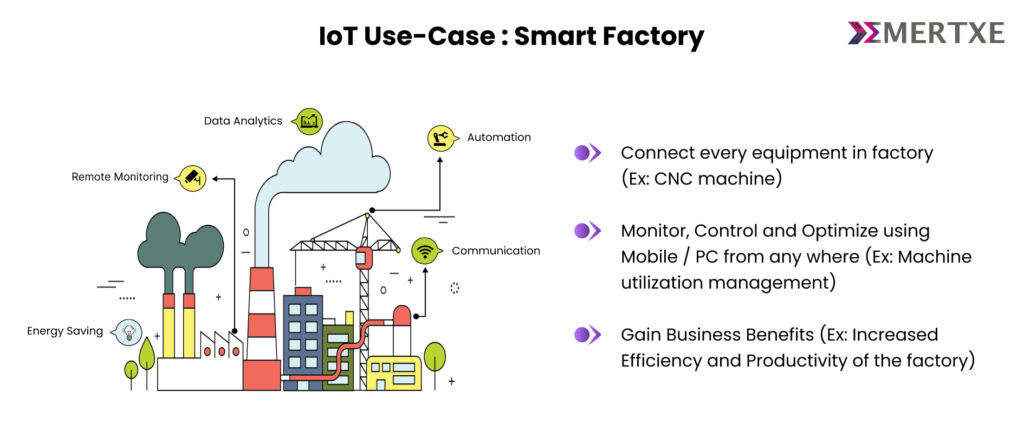
The extensive use of IoT sensors and devices connects machines which gives visibility into the factory processes as well as conditions in creating Industrial Internet of Things or IoT. It’s expected that robots are going to populate smart factories and will be working alongside men.
This will help reduce manpower and will make room for better quality products.Now let’s talk about facility management, which is one of the specific use cases in smart manufacturing. The use of IoT sensors in manufacturing enables condition based maintenance alerts.
There are various critical training tools that are designed to function within certain temperatures and vibration ranges. IoT sensors (1 – IoT device) can actively monitor the machines and send an alert (2 – IoT gateway) when the equipment deviates from the prescribed parameters.
This alert in turn can be captured via the industrial internet (3 – Network), reaching out to the external IoT platform (4 – Cloud). This IoT platform can notify the appropriate personnel in the industry (ex: Floor supervisor) in this mobile application (5 – Application) so that they can take action against the device which is operating beyond its regular parameters.
This will also take care of predictive maintenance of the whole production line.such actions will help in terms of having a prescribed working environment for machinery, reduced costs, eliminate machine downtime, energy consumption and increase the operational efficiency.
Benefits of IoT
Let’s explore the Top 5 Benefits of IoT using the following figure.
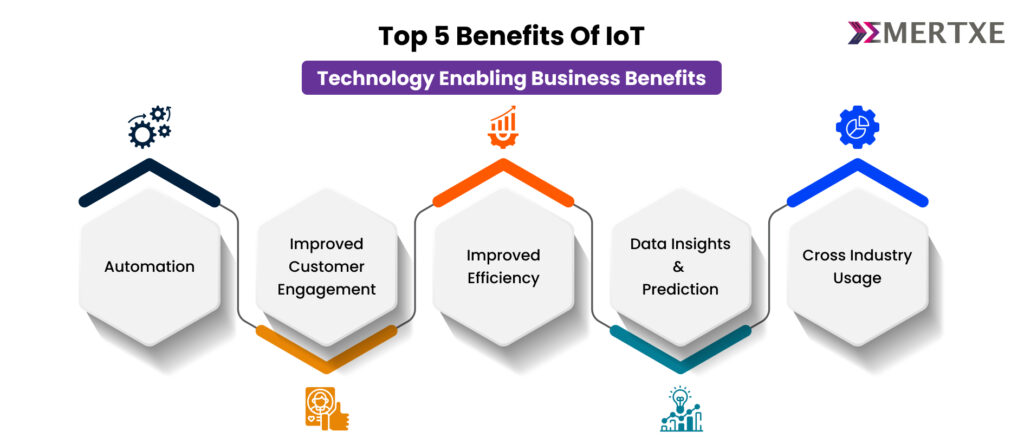
1. Automation
In today’s context, Automation is the key to everything we do – be it home or office or industry. Automation, in the past few years has evolved as the primary factor to efficient mass production and mitigate human errors as well as saving time and reducing cost factors.
Automation, with the benefits of IoT, helps us manage everything from a single place, eliminating the need to go to specific locations. It consolidates all connected devices through a single interface, providing massive convenience. Automation, coupled with the benefits of IoT, offers comfort and convenience, allowing us to perform tasks from one centralized place..
2. Improved Customer Engagement
Customer experience is very important for any company or product. Benifits IoT Figure helps us to get the maximum customer engagement. It helps us to provide a better customer experience.
For example: IoT can improve customer satisfaction by monitoring equipment. The customers can stay connected to their products and devices from anywhere.
3. Improved Efficiency
The Internet of things has taken the world by a storm. It has gained momentum in the business world and successfully managed to do what technology aims to do such as automate processes and drive efficiency remotely.
Moreover, sensors with benefits of IoT, can be deployed almost anywhere to track anything that provides useful data. IoT is very efficient in many fields such as home automation, smart industry, automobiles, retail, agriculture and many more.
4. Data Insights & Prediction
The Internet of things helps us to make better decisions about everything even about the way we trade goods and health care to building smart cities. The internet has connected millions of people across the globe.
No one had anticipated this a decade ago. There are countless interactions between humans and machines that occur over these networks that produce data about almost everything that we do.
It’s not just people that are being connected but a vast network of electronic devices and sensors are constantly transmitting huge amounts of data concerning everything we do.
5. Versatile usage of IoT
Certainly, it’s needless to say that the hype for IoT has been increasing immensely. IoT is a very huge domain. It is implemented is various Here are a few applications showcasing the various IoT verticals, emphasizing the numerous benefits of IoT.
IoT Verticals | Applications |
Industrial Benefits of IoT | Energy networks, Aerospace, Futuristic Farming, Drones, Smart Dust, Smart Robotics, Smart Logistics Management, Power Management, etc. |
Automotive | In vehicle infotainment, predictive maintenance, security, surveillance, safety, data analytics and dashboard reporting, real time monitoring, etc. |
Smart Home | Remote monitoring, energy saving, communication, automation, data analytics, etc. |
Health Care | Tracking and alerts, remote medical assistance, data assortment and analysis, end to end connectivity, simultaneous reporting and monitoring, etc. |
Retail | Predictive equipment maintenance, smart transportation, demand aware warehouse, connected consumer, smart store, etc. |
Logistics | Location management systems, inventory tracking and warehousing, IoT technology and predictive analytics, blockchain for supply chain management, etc. |
Agriculture | Precision farming, agricultural drones, livestock monitoring, smart greenhouses, etc. |
Education | Attendance monitoring system, smart boards, superior safety features, learning at any time anywhere, poster boards into IoT enabled boards, etc. |
Smart City | Smart parking, road traffic, public transport, utilities, street lighting, waste management, environment, public safety, etc. |
Environmental Benefits of IoT | Environmental sensors, smart farming, energy efficiency, energy requirements, etc. |
Emertxe and IoT
In Emertxe we have been working on IoT for a long period of time both in our product development and educational offerings. In our education side we offer a FullStack Embedded IoT course.
Emertxe’s course focuses on programming aspects of IoT Embedded Systems and integration knowledge of the application(IoT) side. IoT is a very broad term that consists of a range of things starting from sensor-to-applications.
Which makes the definition of an IoT engineer quite challenging. From a higher level it can be broken down into Embedded IoT developer and Application IoT developer.
Both embedded and applications need to be worked together to make the end-to-end solution work. Emertxe’s course mainly focuses on the Embedded side. Where participants will be gaining the following skill-sets.
IoT Career Guide
Above all, it is the amalgamation of different technologies coming together. Standards and ecosystem is still evolving. Which often leads to quite a lot of ambiguity and confusion among entry level engineers.
Our team Emertxe has brought in clarity about IoT. By clearly defining it from a skill perspective. This guide is aimed for anyone who wants to build a career in IoT.
IoT Architecture Guide
Likewise, this presentation gives us more insight into IoT architecture and the skills required for getting into great IoT jobs. The presentation is explained with IoT use cases and concluding with an interesting Quiz on IoT in order to validate the participant’s understanding.
Career Tips for IoT
Similarly, this presentation gives details about how an individual can go about Building a great career in the IoT domain. The key differentiation is going to be the skills, which is called out in this presentation.
This information is shared by subject matter experts from Industry in IoT, especially for fresh engineering.
Conclusion
The future of IoT is virtually unlimited due to advances in technology. Consumers desire to integrate devices such as smartphones with household machines. To sum up, Networking and connectivity protocols have made it possible to connect people and machines on all platforms.
Also there is so much data traveling from device to device. Security is another key concern which requires attention to keep up with demands. Moreover, from an individual’s perspective IoT offers excellent career opportunities which need to be harnessed.
However it requires you to have above necessary IoT skills, which is going to be the key differentiator. Are you ready to obtain required skills and conquer the opportunity that IoT offers? Get in touch with us!
| SN | Related Blogs | Links |
|---|---|---|
| 1. | Online Free IoT Internship for Engineering Students | Free Certificates |2023 | Click Here |
| 2. | How IoT Programming Requires More Foundational Skills? | Click Here |
| 3 | What Are the Best Courses in IoT Programming? | Click Here |
People Also Ask(PAA)
The growing IoT landscape is boosting global job opportunities, driven by increased demand for skilled professionals. Industries worldwide are adopting IoT for efficiency and cost reduction, creating a demand for experts in designing, deploying, and maintaining IoT solutions. This surge translates to a rise in job prospects globally.
To thrive in an IoT career, essential skills include proficiency in programming, understanding hardware-software integration.Emertxe Provides hands-on experience in embedded systems, programming, and IoT applications, ensuring participants develop the necessary skills for a successful career in IoT.
In brief, the future of IoT holds immense opportunities for innovation and efficiency, but challenges include security concerns, data privacy issues, and the need for evolving standards to ensure seamless integration
Emertxe’s FullStack Embedded IoT course focuses on developing skills in embedded systems, programming, and IoT applications, providing a comprehensive foundation for a successful career in the field.